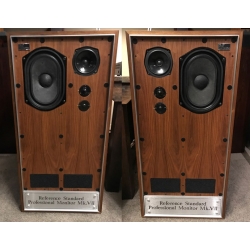IMF Electronics (sold)
This is a very rare set of speakers, the owner mentioned there's only 150 ever made in the UK. This maybe the only one here in Melbourne!!
The IMF's long acclaimed Reference Standard series of loudspeakers, originally designed as laboratory devices, has for many years been established as the reference by which other high fidelity equipment may be evaluated. Over the years, subtle changes and improvements have been made regardless of cost. With the introduction of the Mark VII, a considerable step forward in performance has been achieved.
The mid-range drive unit is now mounted above the tweeters enabling its separately constructed line to be placed in a position improving its rigidity and isolating it from bass line feed-through. Our new tweeter and super tweeter are damped with ferro-fluid giving increased power handling and reduced distortion. They are devoid of face mounting flanges thereby allowing them to be placed close together. An "in-line" configuration has been selected. The result is a tightly placed cluster of drive units that provides imagery of optimum accuracy.
Our bass unit employs a thick but tapered cone constructed of styrene and fibreglass. This design provides a drive unit that is large but has fast response and an extremely high power handling capability. Of course, full transmission line loading is used in the massively built enclosure.
A completely new dividing network has been created, and the result is a superbly integrated and phase coherent transducer, with incomparable performance. Low-loss multi-strand heavy copper cable is used for all internal wiring. The response extends from below audibility to well above the upper limit of the audio spectrum. In the Mark VII design we have been able to reduce distortion characteristics to a level which is unmatched, allowing the listener to assess all types of programme material with an accuracy hitherto unattainable.
The TILT and SLOPE controls act in conjunction with each other to determine the energy response between 300 Hz and 15 kHz. The TILT control in the "Rise" position causes a lift across these frequencies of about 1 dB whilst the "Fall" setting has the opposite effect. (See Figure 2). The SLOPE control affects the response in the 2 kHz region by +- 1 dB through the use of the "Add" and Cut" settings. (See Figure 3). It functions at all positions of the TILT control and, therefore, a wide range of combinations are available. (See Figure 4). By operating the switches on low level random noise (from an off-station tuner for example) these functions can be audibly assessed. Each control setting is deliberately made fine and no configuration will impair the inherent smoothness and phase coherence of the loudspeakers.
The speakers are supplied with these controls in their "Flat" settings which nominally provides the most uniform response under anechoic test conditions. This may not be optimum where room characteristics, positioning, the response of ancilliary equipment and even personal preference could dictate different settings.
For example, speakers situated near reflective surfaces may benefit from lowering the SLOPE control to "Cut", whilst for dry listening acoustics the preferred setting may be "Add". Use of the loudspeakers under conditions of high ambient noise, or in a bass heavy environment, may benefit from lifting the TILT control to "Rise", then making final adjustments with the SLOPE control.
Possible settings for quiet conditions would be to turn the TILT control to "Fall" and perhaps restore the treble energy by switching the SLOPE to "Add". Such combinations would produce a marginally receded midrange - a "loudness" contour that may be preferable at lower listening levels.
It is important that these two pre-set controls, TILT and SLOPE, are not used as "tone controls". They provide only subtle forms of adjustment between laboratory settings and those ideal for the loudspeakers when at their location of use and connected to the equipment eventually driving them. Switching should be carried out at low volume settings. Subsequently, it is only necessary to re-adjust the pre-set controls if either the location of the loudspeakers, or the equipment driving them, is significantly altered. Regular adjustments of balance that may be required between different programme material should be carried out with the amplifier controls.
The mirror-matched enclosures are supplied with stands, and are totally veneered in the finest American Walnut including the baffle and rear surface. We have replaced the standard cloth-covered wooden grille frame with a specially designed acoustically transparent, selfcoloured brown foam. This has minimised edge defraction effects whilst increasing the attractiveness of the whole system when in domestic settings.
This pair is in mint condition, comes with custom black front covers.
SPECIFICATION
Dimensions
1040 x 430 x 500 mm (40 7/8" x 16 7/8" x 19 5/8") wide
Overall height on stand 1160 mm (45 5/8")
Drive Units: 300 x 210 mm (11 3/4" x 8 1/4") Bass unit - styrene/fibreglass cone
130 mm (5") Mid-range engineered polymer cone
45 mm (1 3/4") Tweeter high gauss: ferro-fluid damped
20 mm (3/4") H.F. Tweeter chemical dome: ferro-fluid damped
Crossover Frequencies
350 Hz, 3 kHz and 13 kHz
Frequency Response
17 Hz to 40 kHz
Efficiency
Pink noise at 1 metre - 80 to 82 dB at 1 watt depending upon control settings
Controls
TILT and SLOPE controls
Matching Impedance
8 ohms nominal
Recommended Amplifier Power
Not less than 50 watts per channel RMS
Net Weight
96 Kgs (211.2 Ibs) (pair with stands)
Gross Weight
122 Kgs (280.6 Ibs) (pair with stands)
Cabinet
Heavily braced and deadened high-density epoxy saturated particle board. Internally veneered and finished externally with the finest American Walnut veneer.

